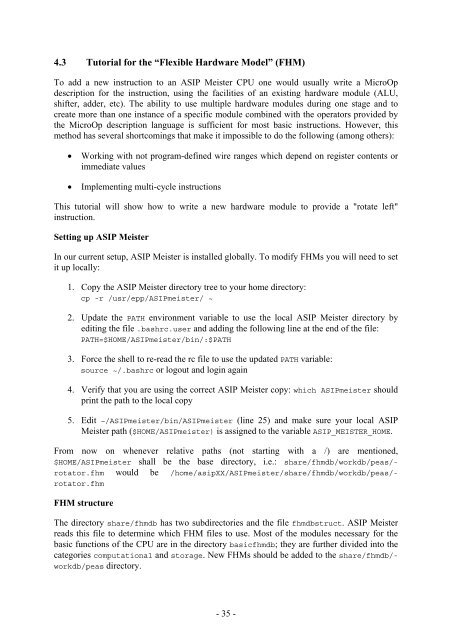Script for Laboratory: Designing embedded ASIPs - CES
Script for Laboratory: Designing embedded ASIPs - CES
Script for Laboratory: Designing embedded ASIPs - CES
Create successful ePaper yourself
Turn your PDF publications into a flip-book with our unique Google optimized e-Paper software.
4.3 Tutorial <strong>for</strong> the “Flexible Hardware Model” (FHM)<br />
To add a new instruction to an ASIP Meister CPU one would usually write a MicroOp<br />
description <strong>for</strong> the instruction, using the facilities of an existing hardware module (ALU,<br />
shifter, adder, etc). The ability to use multiple hardware modules during one stage and to<br />
create more than one instance of a specific module combined with the operators provided by<br />
the MicroOp description language is sufficient <strong>for</strong> most basic instructions. However, this<br />
method has several shortcomings that make it impossible to do the following (among others):<br />
• Working with not program-defined wire ranges which depend on register contents or<br />
immediate values<br />
• Implementing multi-cycle instructions<br />
This tutorial will show how to write a new hardware module to provide a "rotate left"<br />
instruction.<br />
Setting up ASIP Meister<br />
In our current setup, ASIP Meister is installed globally. To modify FHMs you will need to set<br />
it up locally:<br />
1. Copy the ASIP Meister directory tree to your home directory:<br />
cp -r /usr/epp/ASIPmeister/ ~<br />
2. Update the PATH environment variable to use the local ASIP Meister directory by<br />
editing the file .bashrc.user and adding the following line at the end of the file:<br />
PATH=$HOME/ASIPmeister/bin/:$PATH<br />
3. Force the shell to re-read the rc file to use the updated PATH variable:<br />
source ~/.bashrc or logout and login again<br />
4. Verify that you are using the correct ASIP Meister copy: which ASIPmeister should<br />
print the path to the local copy<br />
5. Edit ~/ASIPmeister/bin/ASIPmeister (line 25) and make sure your local ASIP<br />
Meister path ($HOME/ASIPmeister) is assigned to the variable ASIP_MEISTER_HOME.<br />
From now on whenever relative paths (not starting with a /) are mentioned,<br />
$HOME/ASIPmeister shall be the base directory, i.e.: share/fhmdb/workdb/peas/rotator.fhm<br />
would be /home/asipXX/ASIPmeister/share/fhmdb/workdb/peas/rotator.fhm<br />
FHM structure<br />
The directory share/fhmdb has two subdirectories and the file fhmdbstruct. ASIP Meister<br />
reads this file to determine which FHM files to use. Most of the modules necessary <strong>for</strong> the<br />
basic functions of the CPU are in the directory basicfhmdb; they are further divided into the<br />
categories computational and storage. New FHMs should be added to the share/fhmdb/workdb/peas<br />
directory.<br />
- 35 -
















